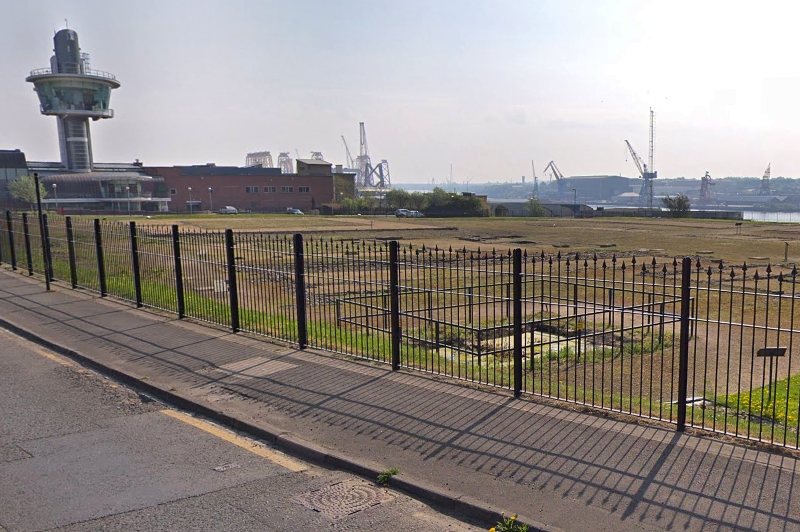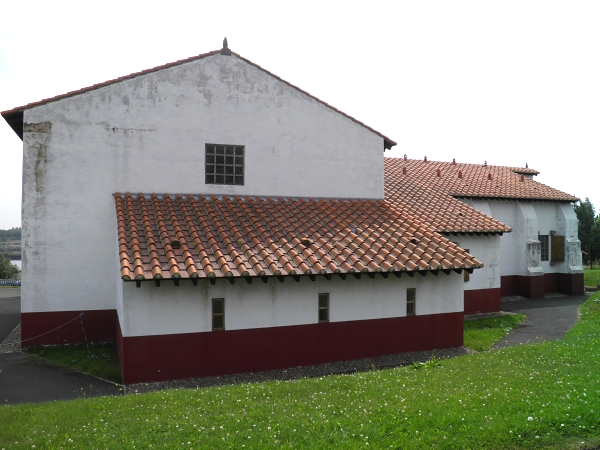
North we head, with the North Sea on my right. The sea is gray and turbulent, and I think of the medieval criminals who chose voluntary exile from Durham, wondering if any of them set sail across these waters with a sense of adventure rather than trepidation.
We have returned to Newcastle upon Tyne and make a turn toward the coast, toward Wallsend to see the ruins of Segedunum, ("Victory Fort") which was the easternmost anchor of Hadrian's Wall. Considering its past, it's fortunate that Segedunum is visible at all.
During the Industrial Revolution the fort was covered with mine buildings and miners' houses. Subsequently shipbuilding became a major source of employment.
The remains lie in a paved area near a defunct shipyard. This is a stark, bleak area, which again reminds me of home and the shipyards and numerous laid-off workers that populate my area. There is a very new looking visitors' center here, with an observation tower that overlooks the reconstructed ruins and the harbor, but it's closed for the day.
After a drive through a seemingly deserted residential area nearby, where everyone must certainly have had their evening meal by now and be stretched out before the telly, we continue our northerly trek, back through Newcastle and into Morpeth in Northumberland.
Dinner is at the Shoulder of Mutton Inn. I feel as if I've walked a hundred miles today and sink down into my seat, blearily studying the menu. I'm famished, and make a quick decision of scampi (fried shrimp) and chips, with salad on the side. Hot, fresh, tasty and accompanied by a half-pint of Theakston's lager this filling meal should revitalize me, but I've been too far down the long and winding road today for it to have that effect.
A steaming shower relaxes me completely, and it's just full dark as I crawl into my warm soft bed. Road weary and exhausted I fluff up the pillows, grab a pen and a handful of postcards and attempt to bring order enough to my senses to coherently convey more than "having a wonderful time" to friends back in the States.
I pick up a card of the wall and address it to my friend whose dream of visiting Paris so inspired me. "I walked atop Hadrian's Wall today," I begin. And then another, of Hermitage Castle, which I address to a young friend who dreams of seeing England and Scotland herself one day. "Don't ever give up your dream," I write, before turning off the light and snuggling down under my duvet for a much needed rest.

Segedunum was a Roman fort at modern-day Wallsend, Tyne and Wear, England. The fort lay at the eastern end of Hadrian's Wall near the banks of the River Tyne, forming the easternmost portion of the wall. It was in use as a garrison for approximately 300 years, from around 122 AD.
Around 400AD the fort was abandoned. For centuries the area remained as open farmland, but in the 18th century, collieries were sunk near the fort and the area gradually became a populous pit village. Eventually, in 1884, the whole fort disappeared under terraced housing.
A section of Hadrian's Wall was excavated and a reconstruction built in the early 1990s. The Segedunum project began in January 1997 with a series of excavations in and around the fort.
The site of the fort now contains the excavated remains of the buildings' foundation of the original fort, as well as a reconstructed Roman military bathhouse based on excavated examples at Vindolanda and Chesters forts.
A museum contains items of interest that were found when the site was excavated; a large observation tower overlooks the site.
Read more about Segedunum at Wikipedia.